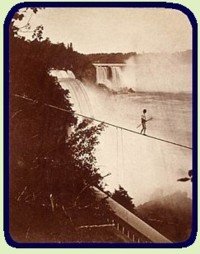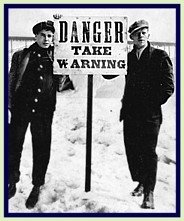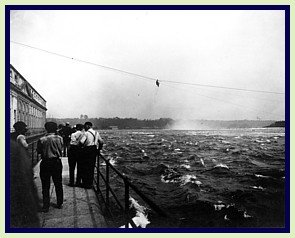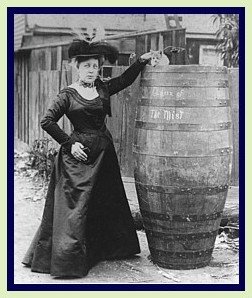Tales of Niagara Falls
by Cathy Marie Buchanan
Author of the historical novel
The Day the Falls Stood Still

Though I was born and bred in Niagara Falls and grew up knowing plenty of the local lore, I wouldn’t fully grasp the quirkiness of the place until I was researching The Day the Falls Stood Still set there in 1915. Much of the peculiarity I discovered made its way into the novel, a smattering of which I will put down here.
The term “the day the falls stood still” was coined back in 1848 to describe the very real day the locals woke to quiet rather than the thunder of the river plummeting over Niagara Falls. With the cliff face of their falls and the riverbed bone dry, some ducked into churches, praying for their salvation with Armageddon so close at hand, and others headed out onto the riverbed, salvaging lost timbers and collecting relics from the War of 1812. In The Day the Falls Stood Still the event marks the arrival of Fergus Cole in Niagara Falls. And then, after years of accurate predictions—the first being that the river was only damned up with ice and would, any moment, come hurtling down the channel—and years of heroic river rescues, folks start saying “the day the falls stood still” was the river’s way of paying homage to Fergus Cole.
Tom Cole, Fergus’s grandson and the riverman central to the plot of The Day the Falls Stood Still, bemoans what he feels is declining reverence for the Niagara River since his grandfather’s time. He says, quite rightly, that people once referred to the falls using phrases like “awful grandeur” and “frightful beauty.” In fact, the book’s epigraph from 1885 uses “awful symbol of Infinite Power, in whose dread presence we stand” to invoke Niagara Falls. The idea that Niagara Falls possessed the power to lure those who gazed at it too long into throwing themselves from the brink was quite widely held. Consider what Harriet Beecher Stowe had to say after visiting Niagara Falls in 1834: “I felt as if I could have gone over with the waters; it would be so beautiful a death; there would be no fear in it.”

While statistics on suicides at Niagara Falls aren’t published, there is a long tradition of rivermen in Niagara Falls fishing bodies from the river. In fact, William “Red” Hill, the most famous of Niagara’s rivermen and the inspiration behind Tom Cole, hauled 177 bodies from the river in his lifetime (1888-1942).
Like my fictionalized version of him, Red Hill was born with a caul and had an uncanny knowledge of the river, a knowledge he would pass on to his sons. It was said he could predict the weather simply by listening to the roar of the falls, also that he would wake in the night knowing he would find a body tossing in the river the following day. He was credited with rescuing 29 people and hundreds of animals and birds.
 His two most daring rescues are retold in The Day the Falls Stood Still. The second occurred on August 6, 1918, when a scow dredging the entrance of a hydroelectric canal on the river broke free of its tug and drifted toward the falls with two deckhands aboard. After becoming lodged on a rock shoal, the men worked feverishly, shifting much of the scow’s load to the front and building a makeshift windlass from timbers pulled from the scow’s interior. A lifeline gun arrived from the Youngstown Life Saving Station, and a line was successfully shot to the men from the roof of one of the powerhouses on the river. By the time the line was secured to the windlass, darkness had arrived. When the lines of the breeches buoy, meant to transport the men to safety, became snarled, William “Red” Hill went out along the line but was unable to untangle the buoy. At dawn, he journeyed out again. This time he was successful, and the stranded men were returned to shore. The scow still remains at the same spot where it became stuck in 1918.
His two most daring rescues are retold in The Day the Falls Stood Still. The second occurred on August 6, 1918, when a scow dredging the entrance of a hydroelectric canal on the river broke free of its tug and drifted toward the falls with two deckhands aboard. After becoming lodged on a rock shoal, the men worked feverishly, shifting much of the scow’s load to the front and building a makeshift windlass from timbers pulled from the scow’s interior. A lifeline gun arrived from the Youngstown Life Saving Station, and a line was successfully shot to the men from the roof of one of the powerhouses on the river. By the time the line was secured to the windlass, darkness had arrived. When the lines of the breeches buoy, meant to transport the men to safety, became snarled, William “Red” Hill went out along the line but was unable to untangle the buoy. At dawn, he journeyed out again. This time he was successful, and the stranded men were returned to shore. The scow still remains at the same spot where it became stuck in 1918.
Red Hill also shot the lower rapids in a barrel three times. The parade of daredevils at Niagara Falls began with Blondin, who successfully crossed the Niagara Gorge on a tightrope eight times in 1859. The following summer Farini became his rival, with each trying to outdo the other as they crossed the gorge. Blondin would carry his manager on his back. Farini would descend from the midpoint of the tightrope to the deck of the Maid of the Mist before climbing back up to tightrope and finishing his walk. Blondin would counter, carrying a stove on his back and cooking an omelet mid-crossing, and then Farini would strap a washtub to his back, lower a bucket to the river below and mid-rope wash a dozen handkerchiefs. On it went.
 Eventually barrels replaced tightropes as the favoured means with which to conquer the Niagara River, and in 1901, on her 46th birthday, Annie Taylor, a widow and school teacher from Bay City, Michigan, climbed into a barrel packed with padding, and the lid was screwed into place. She was first to survive the plunge over the falls.
Eventually barrels replaced tightropes as the favoured means with which to conquer the Niagara River, and in 1901, on her 46th birthday, Annie Taylor, a widow and school teacher from Bay City, Michigan, climbed into a barrel packed with padding, and the lid was screwed into place. She was first to survive the plunge over the falls.
Since then fourteen more attempts have been made, with all but five surviving to tell the tale. One of the most gruesome failures happened in 1920, when Charles Stephens decided to affix an anvil to his barrel to keep it upright. To minimize the thrashing he would surely take inside the barrel, he tied his feet to the anvil and strapped his arms to the sides of the barrel. After the plunge, only his severed arm was recovered, tattooed with the words “Forget me not, Annie.” Of course, I couldn’t resist including this gory bit of lore in The Day the Falls Stood Still.
The never-ending stream of wondrous Niagara Falls lore continues, and I continue to take note, with unfaltering fascination, though some of it is impossible to overlook—incidents like a high school boyfriend’s brother surviving the plunge over the falls in a barrel wearing only cowboy boots and a hat.
Cathy Marie Buchanan is the author of The Day the Falls Stood Still, a love story set at Niagara Falls in 1915, available from Powell's Books or Amazon.com .
.
Photographs:
#1 – Tightrope walking; George Barker, Library and Archives Canada, PA-181218
#2 – William “Red” Hill (at right); Niagara Falls (Ontario) Public Library
#3 – Scow rescue; Niagara Falls (Ontario) Public Library
#4 – Annie Taylor and her barrel; Niagara Falls Pubic Library, Niagara Falls, NY
Top of Page
Back to Directory of Articles
copyright Cathy Marie Buchanan 2009
Enjoy this page? Please pay it forward. Here's how...
Would you prefer to share this page with others by linking to it?
- Click on the HTML link code below.
- Copy and paste it, adding a note of your own, into your blog, a Web page, forums, a blog comment, your Facebook account, or anywhere that someone would find this page valuable.